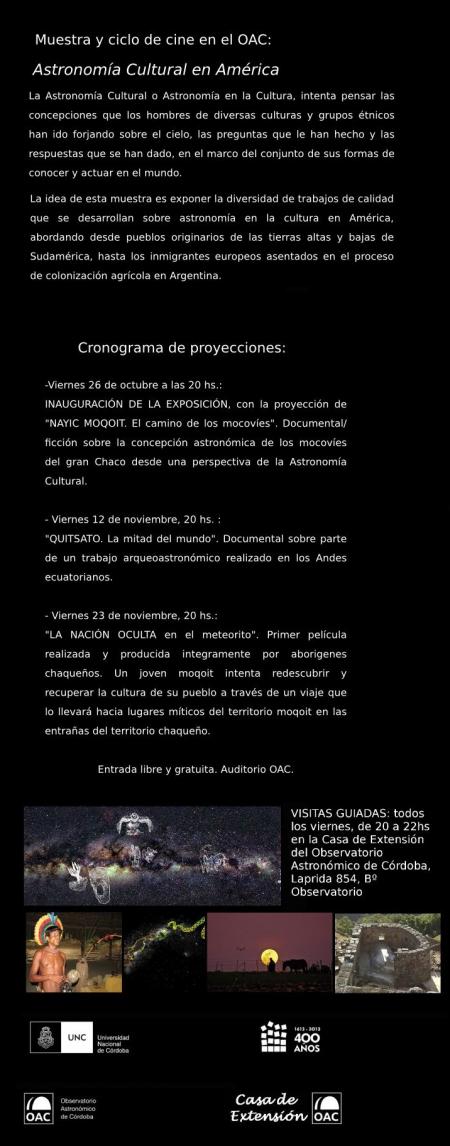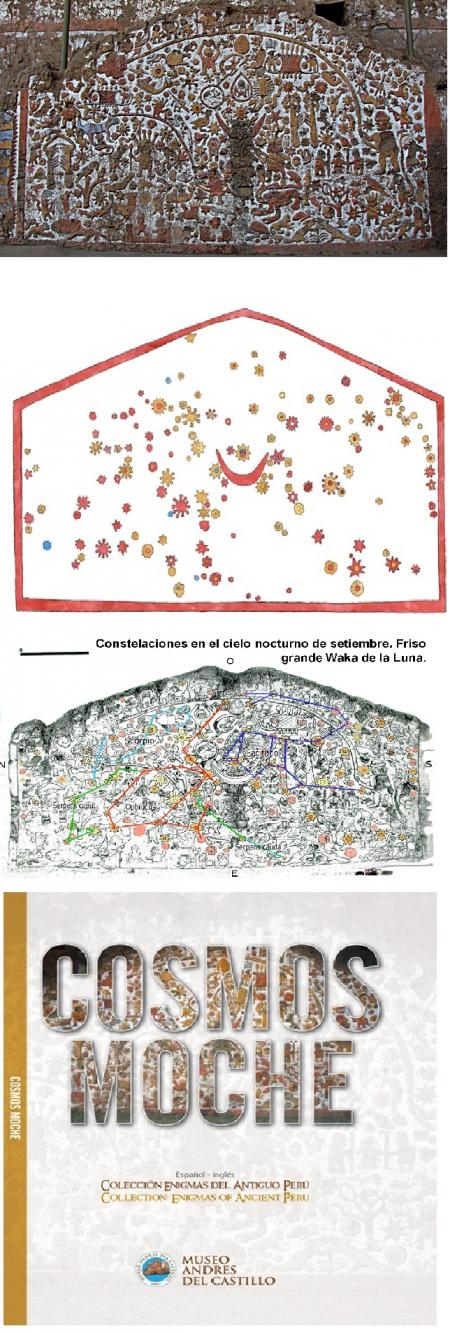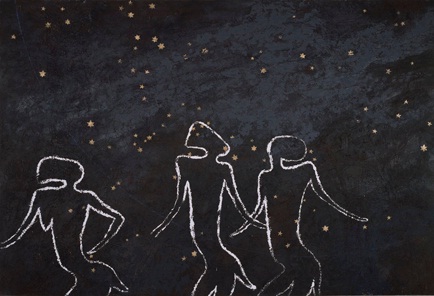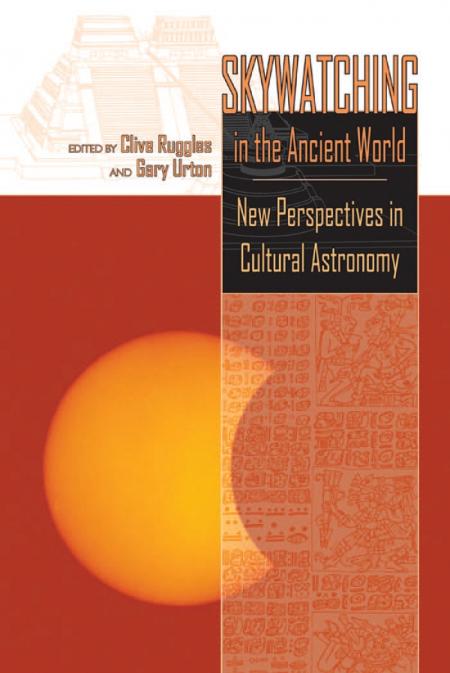
Observatorio Astronómico de Córdoba
Información Armando Mudrik
Sigue leyendo
Archivo por meses: octubre 2012
El Cosmos en la antigua sociedad pre-hispánica Mochica
Link: Libro Cosmos Moche

En el libro COSMOS MOCHE: El “orden” del mundo terrenal creado por los mochicas y también sus conocimientos sobre ese “orden” que habitaba el cielo. Desde los solsticios y equinoccios que marcan el tránsito del Sol durante todo el año, hasta las fases de la Luna, pasando por el mapa estelar que contemplaron en el cielo nocturno. Desde la denominada Vía Láctea, identificada como un río (mayu) celestial, cuyas sombras provocaron mitos y tradiciones andinas; hasta las constelaciones de estrellas cuyo movimiento sirvió como calendario astronómico. Y la identificación del movimiento de ciertas estrellas y planetas que fueron vinculados a los ancestros mitológicos.
Ver la información completa en:
EL 11-S DE LOS MOCHES Sigue leyendo
Skywatching in the Ancient World New Perspectives in Cultural Astronomy
Compiled in honor of Anthony F. Aveni, America’s leading archaeoastronomer, Skywatching in the Ancient World offers state-of-the-art work in cultural astronomy by well-known experts in Mayan glyphic studies, cultural history, ethnohistory, and the history of science and of religions.
This collection’s wide range of outstanding scholarship reveals that cultural astronomy has come into its own. The diverse topics addressed by the contributors include the correlation between Colonial Northern Zapotec and Gregorian calendars, the period of use of the Dresden Codex Venus table and the significance of the Lunar Almanacs that precede it, a new interpretation of an Inka tapestry mantle as a commemorative calendar, temple orientations in Hawai’i and church orientations in Medieval England, and the connection in cultural imagery between astronomers (science) and wizards (magic).
Contributors include: Harvey M. Bricker, Victoria R. Bricker, Edward E. Calnek, Clemency Coggins, John Justeson, Edwin C. Krupp, Stephen C. McCluskey, Susan Milbrath, Clive Ruggles, David Tavárez, Barbara Tedlock, Dennis Tedlock, Gary Urton, and R. Tom Zuidema.
Mesoamerican Worlds Series
“With its stunning array of diverse approaches, from the Maya Dresden Codex to Hawaiian astronomy to the alignment of Medieval English churches . . . this volume presents a series of important articles written by eminent scholars in the field of cultural astronomy. In terms of edited volumes, it is the most important contribution to the field in recent memory.”
-Grant Aylesworth, University of New Brunswick
“The series of papers necessarily utilize a diverse combination of methodological and interdisciplinary approaches to interpret past social practices related to astronomy. This book will be of interest not only to archaeologists working in Mesoamerica but also to anthropologists who “seek to understand how perceptions of the sky have influenced, and can influence, human thought and action” (p. 12).”
-Reiko Ishihara, The Americas
“Summing up: Highly Recommended.”
-CHOICE reviews
Review
Reiko Ishihara
From: The Americas
Volume 65, Number 3, January 2009
pp. 424-426 | 10.1353/tam.0.0074
In lieu of an abstract, here is a brief excerpt of the content:
This book represents the current state of the field of archaeoastronomy, or rather cultural astronomy, and is a tribute to Anthony Aveni’s pioneering contributions that have defined and continue to shape the “anthropology of astronomy.” The book title likely stems from Anthony Aveni’s Skywatchers of Ancient Mexico (1980; rev. 2001) publication, reflecting the theoretical and methodological developments of the field referred to by the editors as “social contextualization” (p. 2), and specifically points to a change in scholarly focus from the skywatchers to skywatching, from studying ancient astronomy to emphasizing social processes and practices related to cultural cosmologies and the sky.
The volume includes an introductory section by Ruggles and Urton, Davíd Carrasco, and Lorraine Aveni, and consists of 11 chapters that represent the topical and geographical diversity that Aveni’s work has influenced. In the Introduction, the editors present a theoretical overview of the field, commenting that the set of papers demonstrate “the relevance of cultural astronomy today to broader social questions, especially where these sit at the interface between cultural anthropology, history, and archaeology” (p. 3). The first six chapters focus on Mesoamerica, Aveni’s principal area of specialization; two chapters concern the Inka region. The final three chapters reflect Aveni’s contributions to methods and practice in cultural astronomy.
Chapter 1 by John Justeson and David Tavárez and Chapter 2 by Edward E. Calnek, present compelling evidence of the institution of calendar reforms after AD 1000 in Oaxaca and after 1507 in Tenochtitlan, respectively. These papers remind scholars that calendars themselves are socio-cultural products functioning within a dynamic process that were manipulated and transformed by the users. The next chapters take up different sections of the Dresden Codex examining when and how it may have been used. Harvey and Victoria Bricker convincingly argue that the Venus table, whose function was a warning device, dates to the Terminal Classic and was used through the Early Postclassic. Dennis and Barbara Tedlock identify the deities depicted with the lunar goddess as particular constellations by correlating the types of interactions with the goddess to sidereal locations. Another case study that links prehispanic documents with practice is presented by Susan Milbrath, who reexamines a portion of the Codex Borgia suggesting that they do not depict the 584-day Venus synodic cycle but rather the historical record of rituals and associated celestial events in the festival cycle of the year 1496.
Amidst the transformative social processes that are highlighted throughout the book, Clemency Coggins points to the historical continuity of a cognitive framework that forms the foundation of time and distance. Chapter 6 concerns basic systems of bodily measurement used throughout Mesoamerican history and their relationship to calendars. In Chapter 7, Gary Urton presents an intriguing analysis on the spatial organization of the geometrical designs that comprise a particular Andean tapestry, arguing that it represents a historically structured, commemorative five-year calendar as a publicly accessible medium akin to stelae in the Maya area. In Chapter 8, contrasting with Mesoamerican calendric systems, R. Tom Zuidema suggests the importance of lunar observations and its connection with solar movements in the Cuzco calendar. In Chapter 9, Clive Ruggles discusses methodological challenges in interpreting Polynesian temple orientations where navigational astronomy played a prominent role, emphasizing the importance of cultural context via oral history and ethnography. In Chapter 10, Stephen C. McCluskey uses medieval texts to revisit the assumption that churches were oriented to the ambiguously defined “equinoctial east” and examines the corresponding religious symbolism. The final paper by Edwin C. Krupp brings the theme’s astrological significance into focus, tracing the iconic transformations of the perceived role of shamans and wizards cross-culturally as well as through time. Just as different perceptions of the sky reflect varied cosmological beliefs and practices, the history of occult magic likewise reveals distinct experiences of reality.
The series of papers necessarily utilize a diverse combination of methodological and interdisciplinary approaches to interpret…
Información Disponible en: http://muse.jhu.edu/books/9780870819803 Sigue leyendo
Exploraciones en Astronomía Cultural – Explorations in Cultural Astronomy. En el NMAI

Explorations in Cultural Astronomy
When: Saturday, October 20, 2012, 2 – 4:30 PM
Categories : Lectures & Discussions, Webcasts & Webinars
Venue: Washington D.C. American Indian Museum
Event Location: Rasmuson Theater, 1st Level
Webcast: nmai.si.edu…
Cost: Free
Related Exhibition:
African Cosmos: Stellar Arts, on view at the National Museum of African Art
Details:
In Indigenous worldviews — where humanity, nature, and the spiritual realm are closely connected — the night sky provides spiritual and navigational guidance, timekeeping, weather prediction, and stories and legends that tell us how to live a proper life. Cultural astronomy, also referred to as archaeoastronomy or ethnoastronomy, explores the distinctive ways that astronomy is culturally embedded in the practices and traditions of various peoples. In this symposium, experts Michael Wassegijig Price, John MacDonald, Gary Urton, and Babatunde Lawal discuss the cultural astronomy traditions of four indigenous regions/cultures: Ojibwe, Inuit, Andean, and African.
For further information, please contact NMAI-SSP@si.edu.
Photo caption: Gavin Jantjes, b. 1948, South Africa, Untitled, 1989–90, Acrylic on canvas, Collection of the National Museum of African Art. Photo by Frank Khoury/Smithsonian Institution.
Coloquio internacional: “Tiempo y complejidad. Calendarios del mundo – Time and complexity. Calendars of the world’

Coloquio internacional:
“Tiempo y complejidad. Calendarios del mundo –
Time and complexity. Calendars of the world”
Coordinación Académica: Diana Magaloni, Ana Díaz, Francisca Zalaquett
9, 10 y 11 de octubre, 2012
10:00 – 19:00 hrs.
Museo Nacional de Antropología
Av. Paseo de la Reforma y calzada Gandhi s/n,
Col. Chapultepec Polanco, Delegación Miguel
Hidalgo, C.P. 11560. México, D.F.
Programa:
Martes 9 de octubre
10:00 | Inauguración
MESA 1
Calendarios de Asia y el Pacífico.
Calendars of Asia and the Pacific.
11:00 – 11:20 | Un orden perfecto. Tiempo cíclico en la ecología y sociedades
balinesas.
Perfect order: Cyclical Time in Balinese Ecology and Society
Thérèse de Vet. (Department of Anthropology, University of Arizona).
En colaboración con Steve Lansing (Santa Fe Institute, Nuevo México).
11:25 – 11:45 | Estaciones, direcciones y alteridades; tiempo y ontología
política en la China temprana.
Seasons, directions, and alterities: time and political ontology of early China.
Wang Mingming (Department of Sociology, University of Pekin).
11:50 – 12:10 | Tiempo dual en Sipsongpanna: un estudio de la representación
del tiempo que articula las religiones y sociedades locales.
Dual time system in Sipsongpanna: A Study of the representation of Time in
religions and local society.
Yang Qingmei (National Institute of Social Development, Chinese Academy of Social
Sciences).
12:10 – 12:30 | Receso /Coffee break
12:30 – 12:50 | Conocimiento calendárico en la organización de los tiempos
en la región nororiental del Kula.
Calendrical Knowledge in the Organization of Times in the Northeastern Kula
Ring.
Fred Damon (Department of Anthropology, University of Virginia).
13:00 – 13:30 | Discusión. Moderador: Carlos Mondragón (Centro de Estudios de Asia
y África, El Colegio de México).
MESA 2:
Calendarios Americanos de los hemisferios norte y sur.
American Calendars from Northern and Southern
Hemispheres.
16:00- 16:20 | Los centros ceremoniales administrativos como
calendarios en el Imperio Inka.
Ceremonial Administrative Centers Working as Calendars in Inka
Empire.
José Luis Pino Matos (Programa de Estudios Andinos, Pontificia Universidad Católica
de Perú).
16:25 – 16:45 | El calendario inca y las sociedads costeñas en el
Wamani de Pachacámac. Los frisos calendáricos de Huaycán de
Cieneguilla y otros asentamientos.
The Inca Calendar and Coastal Societies in Wamani Pachacámac.
The friezes of Cieneguilla Huaycán calendrical and other
settlements.
Juan Pablo Villanueva Hidalgo (Universidad Mayor de San Marcos, Lima)
16:50 – 17:10 | La complejidad del tiempo ritual huichol.
The Complexity of Huichol Ritual Time.
Johannes Neurath (Museo Nacional de Antropología).
17:10 – 17:30 | Receso /Coffee break.
17:30- 17:50 | A:shiwi A:wan Uhlonnane: El mundo Zuni.
A:shiwi A:wan Uhlonnane: The Zuni World.
James Enote (A:siwi A:wan, Museum and Heritage Center).
18:00- 18:30 | Discusión. Moderador: Federico Navarrete (Instituto de
Investigaciones Históricas, UNAM).
Miércoles 10 de octubre
MESA 3.
Mesoamérica I. Tiempo y calendarios en Oaxaca.
Mesoamerica I. Time and Calendars of Oaxaca, Mexico
10:00 – 10:20 | La lista de 260 días y la imagen mántica.
The 260-day count and mantic imagery.
Sebastián van Doesburg (Instituto de Investigaciones Sociológicas de la UAB JO; Centro
Académico y Cultural San Pablo, Oaxaca).
10:25 – 10:45 | Los registros calendáricos del Clásico en la Mixteca
Baja.
Calendrical Texts from the Lower Mixteca in the Classical Period.
Laura Rodríguez Cano (Escuela Nacional de Antropología e Historia).
10:50 – 11:10 | El piyé o la cuenta zapoteca de 260 días: ruptura
y continuidad en el sistema mántico.
Piyé: The Zapotec 260-day Count. Continuity and Rupture in the
Mantic System.
Michel Oudijk (Instituto de Investigaciones Filológicas, UNAM).
11:10 – 11:30 | Receso /Coffee break
11:30 – 11:50 | Tiempos y espacios; pluralidad de calendarios entre los
mixes de Oaxaca.
Time and Space; Calendrical Plurality among the Mixe of Oaxaca.
Emiliano Zolla (Instituto de Investigaciones Antropológicas, Universidad Nacional
Autónoma de México).
12:00 – 12:30 | Discusión. Moderador: Manuel Hermann (Centro de Investigaciones
y Estudios Superiores en Antropología Social, México).
MESA 4.
Mesoamérica II. Calendarios mexicanos.
Mesoamerica II. Mexican Calendars.
15:00- 15:20 | Los distintos cronotopos mexicas.
The Diversity of Mexica Chronotopes.
Federico Navarrete (IIH; UNAM)
15:25 – 15:45 | La cuenta del tiempo entre los nahuas: diacronía y
amplitud temporal.
The Nahua Calendar: Diachrony and Temporal Length.
Eduardo Natalino Dos Santos (Departamento de Historia, Universidad de São Paulo)
15:50 – 16:10 | El alfa y la omega. El concepto civil y religioso del
tiempo en la Nueva España.
Alpha and Omega. Civil and religious temporal concepts in New Spain.
Alberto Soto (Departamento de Arte, Universidad Iberoamericana)
16:10 – 16:30 | Receso /Coffee break
16:30 – 16:50 | El tiempo en los códices nahuas; nuevos registros para
antiguos conceptos.
Time and the Nahua Codexes; New Calendrics for Ancient Concepts.
Ana Díaz (Instituto de Investigaciones Históricas de la UNAM).
17:00 – 17:30| Discusión. Moderador: Diana Magaloni. (Museo Nacional de
Antropología; Instituto de Investigaciones Estéticas, UNAM).
Jueves 11 de octubre
MESA 5.
Mayas. Calendarios de Yucatán (1º Parte).
The Mayas: Calendars from Yucatan, Part 1.
11:00 – 11:20 | El calendario maya en las tierras bajas del Clásico.
The Calendar in the Classic Mayan Lowlands.
Erik Velásquez (Instituto de Investigaciones Estéticas, UNAM).
11:25 – 11:45 | El calendario en los textos jeroglíficos de Yucatán
The Calendar in Hieroglyphic Texts from Yucatan.
Erik Boot (Investigador independiente, Leiden, Holanda).
11:50 – 12:10 | Contando el tiempo: señores y calendarios en las vasijas
de estilo Chocholá.
Telling Time: Calendrics and Lords in the Chocholá Style.
Maline Werness-Rude (Humboldt State University, Arcata, California).
12:10 – 12:30 | Receso /Coffee break
12:30 – 12:50 | La estructura temporal de los Códices Dresde y París.
Temporal Structure in the Dresden and Paris Codexes.
Laura Sotelo (Centro de Estudios Mayas, Instituto de Investigaciones Filológicas,
Universidad Nacional Autónoma de México).
13:00 – 13:30 | Discusión. Moderador: Octavio Esparza (Facultad de Filosofía y
Letras, UNAM)
Continuación Mesa 5.
Mayas. Calendarios de Yucatán (2º Parte).
The Mayas: Calendars from Yucatan, Part 2.
16:00 – 16:20 | Los calendarios y la representación del
tiempo en el Códice Madrid.
Calendars and the Representation of Time in the Madrid
Codex.
Gabrielle Vail (New College, Florida)
16:25 – 16:45 | Calendarios europeos e indígenas en el
Chilam Balam de Ixil.
Indigenous and European Calendars in the Chilam Balam
of Ixil.
Laura Caso (Colegio de Postgraduados, Puebla)
16:50 – 17:10 | El cómputo del tiempo en el Códice Pérez.
Time Computation in the Codex Pérez.
Florencia Scandar (Universidad Complutense, Madrid)
17:10 – 17:30 | Receso /Coffee break
Ponencia.
Calendarios mayas actuales.
Contemporary Mayan Calendars.
17:30- 17:50 | Cholq’ij: la cuenta de 260 días que hoy
usan los K’iche’ de Guatemala.
Cholq´ij: the 260-day Count among the contemporary
K´iche´of Guatemala.
Iván Canek Estrada Peña (Facultad de Filosofía Letras, UNAM).
18:00 – 18:30 | Discusión. Moderador: Erik Velásquez (Instituto de
Investigaciones Estéticas, UNAM).
19:00 | Clausura
Informes e inscripciones
Departamento de Promoción Cultural del MNA
T. 5553 6381 y 86 ó 4040 5300 ext. 412308
www.mna.inah.gob.mx Sigue leyendo
